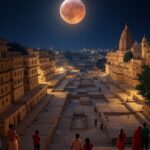
A Definitive Report on the Total Lunar Eclipse of September 2025 in India
Executive Summary: A Celestial Event of Historic Proportions
The user’s inquiry regarding a lunar eclipse occurring today is based on a misunderstanding of astronomical schedules. There is no significant lunar eclipse happening at the present time. However, the next major celestial event of this kind is the Total Lunar Eclipse scheduled for the night of September 7-8, 2025. This event, often referred to as a “Blood Moon,” is of particular importance due to its rarity and exceptional duration.
This eclipse is distinguished by an unusually long period of totality, lasting approximately 82 minutes, which ranks it among the lengthiest lunar eclipses in a decade. Its visibility is a key factor in its global significance, as it will be observable to a vast majority of the world’s population, with viewers across Asia, Europe, Africa, and Australia all poised to witness the spectacle. For observers in India, the entire country will be able to view the eclipse in its full splendor, provided the skies are clear.
The phenomenon is a spectacular demonstration of orbital mechanics and atmospheric physics, where the Earth’s shadow casts a coppery-red glow upon the Moon. Beyond its scientific significance, the event holds deep cultural and spiritual importance in India, where it is known as “Chandra Grahan” and is accompanied by a traditional period of ritual and reflection known as “Sutak Kaal”. This report provides a comprehensive guide to understanding this historic event, from its precise timings and scientific principles to its cultural implications and practical viewing advice.
Key Timings for India (IST)
The following table provides a summary of the critical timings for the eclipse, as measured in Indian Standard Time (IST).
| Eclipse Phase | Date & Time (IST) |
| Penumbral Phase Begins | September 7, 2025, 8:58 PM |
| Partial Eclipse Begins | September 7, 2025, 9:57 PM |
| Total Eclipse (Blood Moon) Begins | September 7, 2025, 11:00 PM |
| Maximum Eclipse | September 7, 2025, 11:41 PM |
| Total Eclipse Ends | September 8, 2025, 12:22 AM |
| Partial Eclipse Ends | September 8, 2025, 1:26 AM |
| Penumbral Phase Ends | September 8, 2025, 2:25 AM |
| Total Duration | 5 hours, 27 minutes |
| Totality Duration | 82 minutes |
The Celestial Spectacle: Date, Time, and Visibility in India
The total lunar eclipse of September 7–8, 2025, is poised to be one of the most remarkable astronomical events of the year, visible across a significant portion of the globe. For observers in India, the entire celestial show will be observable, from the initial, subtle entry into the Earth’s shadow to the full, dramatic “Blood Moon” phase and its conclusion.
The event unfolds over a period of several hours, with distinct phases that offer varying viewing experiences. The penumbral phase, which begins at 8:58 PM IST, is characterized by a subtle, almost imperceptible dimming of the Moon as it enters the Earth’s outer, lighter shadow. This is followed by the partial eclipse at 9:57 PM, a more visible phase where the Earth’s darker, central shadow begins to take a “bite” out of the lunar disk.
The climax of the event is the total eclipse, or Blood Moon phase, which commences at 11:00 PM IST. During this period, the Moon is completely engulfed by the darkest part of the Earth’s shadow, the umbra, yet it remains visible with a striking reddish glow. The eclipse reaches its maximum point at 11:41 PM, when the Moon is closest to the center of the umbra. This dramatic totality phase will last for a remarkable 82 minutes, concluding at 12:22 AM on September 8th. The Moon will then gradually emerge from the shadow, with the partial phase ending at 1:26 AM and the entire event concluding at 2:25 AM.
Minor variations in timing may be noted across different sources, typically by a minute or two. These minor discrepancies are common and can be attributed to factors such as source rounding, slight differences in astronomical models, or calculations based on slightly different geographical coordinates. However, the general timeframe and the duration of the key phases remain consistent across all reports, providing a reliable schedule for observers.
The unparalleled visibility of this total lunar eclipse is a key feature that elevates it beyond a typical celestial event. It is one of the few total eclipses that will be entirely observable from all parts of India, a phenomenon not seen since 2018. Observers in major cities such as Delhi, Mumbai, Bengaluru, Chennai, Kolkata, and Hyderabad will all have an unobstructed view, provided local weather conditions allow for clear skies. This broad visibility transforms the event from a regional spectacle into a shared national experience.
The exceptional length of the totality phase is not a coincidence but is a direct consequence of a rare convergence of astronomical factors. The Moon will be near its apogee, the point in its elliptical orbit farthest from Earth, causing it to move more slowly across the sky. Simultaneously, the Moon’s orbital path will take it through a deep, central cut within the Earth’s umbra, maximizing the duration of its time in the darkest part of the shadow. This combination of slow movement and a central trajectory is what results in the prolonged 82-minute totality, making this event one of the most significant and extended lunar eclipses in recent memory.
The Science Behind the ‘Blood Moon’
A lunar eclipse is a celestial phenomenon that occurs when the Sun, Earth, and Moon align in a near-perfect straight line, with the Earth positioned directly between the Sun and the Moon. This alignment can only occur during the full moon phase. As the Earth blocks direct sunlight from reaching the Moon, it casts a shadow into space, and when the Moon passes through this shadow, it appears to darken or take on a specific coloration.
Earth’s shadow is composed of two distinct parts: the lighter, outer shadow known as the penumbra, and the darker, central shadow called the umbra. During a total lunar eclipse, the Moon passes completely into the umbra. While it might be expected to vanish into complete blackness, a far more spectacular event unfolds. The Moon takes on a deep, striking reddish-orange hue, giving rise to the popular and evocative term, “Blood Moon”.
The appearance of a “Blood Moon” is a direct result of a physical process known as Rayleigh scattering, the same principle that causes sunsets and sunrises to appear red. As sunlight travels through the Earth’s atmosphere, it interacts with air molecules. Shorter wavelengths of light, such as blue and green, are scattered out, while longer wavelengths, primarily red and orange, are not scattered as easily. Instead, these longer wavelengths are bent, or refracted, by the Earth’s atmosphere and are directed onto the surface of the Moon. The Moon is then illuminated by this filtered, reddish light, causing it to glow in magnificent shades of copper and crimson. The exact color of the Moon during totality can vary depending on the level of dust, smoke, or volcanic ash present in the Earth’s atmosphere at the time of the eclipse.
The use of the term “Blood Moon” in popular discourse highlights a fascinating connection between scientific phenomena and their cultural interpretation. While it is not a formal astronomical term, it effectively describes the visual outcome of Rayleigh scattering and serves to capture the public’s imagination. This popular terminology makes a complex physical process accessible and connects to the rich history of human observation and interpretation of celestial events.
This particular eclipse is considered special not just for its visual effect, but for its longevity. The extraordinary duration of the 82-minute totality is a rare occurrence resulting from the Moon’s orbital position. During the eclipse, the Moon will be near its farthest point from Earth, known as apogee. At this distance, its apparent movement across the sky is slower, allowing it to spend a longer time passing through the Earth’s umbra. Furthermore, the Moon will follow a deep, central path through this darkest part of the shadow, maximizing its time in totality. This combination of factors, a slow-moving Moon on a central trajectory, is a rare astronomical alignment that culminates in the extended totality and stunning visual spectacle expected on September 7, 2025.
A Fusion of Science and Spirit: Cultural and Traditional Beliefs
In India, a lunar eclipse is not merely an astronomical phenomenon but a spiritually significant event known as Chandra Grahan. This year’s eclipse is particularly noteworthy as it coincides with Pitru Paksha Purnima, a period dedicated to honoring ancestors. According to Hindu tradition and Vedic astrology, an eclipse is a time when cosmic energies are believed to be disturbed, creating a spiritually sensitive or inauspicious period. This phase of heightened energy is referred to as
Sutak Kaal.
The Sutak Kaal is a period of reflection and self-discipline that begins roughly nine hours before the eclipse and continues until the event concludes. During this time, many households and individuals adhere to a set of traditional practices and precautions. These rituals are believed to safeguard spiritual purity, minimize exposure to potentially “unclean” energies, and encourage inward focus.
The advice to abstain from certain activities during an eclipse is not solely rooted in spiritual beliefs. While Hindu scriptures and astrological texts explain the rationale through cosmic energies and the influence of shadowing planets, there are also practical and historical interpretations. For instance, the prohibition on eating cooked food is sometimes explained by the historical lack of food preservation, as cooked food was thought to spoil more rapidly during this time. The use of Tulsi leaves or Kusha grass to protect stored food is similarly linked to the plants’ purifying and antibacterial properties, demonstrating a form of practical wisdom embedded within traditional practices.
The contemporary understanding of a lunar eclipse, as a safe and natural astronomical event with no physical harm, exists alongside these deeply held cultural beliefs. The two perspectives are not necessarily contradictory; rather, they represent different frameworks for interpreting the same event. Science provides a physical explanation for light and shadow, while tradition offers a spiritual and psychological guide for navigating a period perceived as energetically unique. The observance of these traditional practices transforms the cosmic event into a personal opportunity for prayer, purification, and spiritual development.
Traditional Do’s and Don’ts During Chandra Grahan
The following is a summary of common practices and precautions traditionally observed during Chandra Grahan and the associated Sutak Kaal.
| Category | Recommended Activities (Do’s) | Prohibited Activities (Don’ts) |
| Personal & Spiritual | Engage in meditation, chanting mantras, and prayer. Take a purifying bath before and after the eclipse. Stay awake during the eclipse. | Avoid sleeping during the eclipse. Do not cut hair or nails. Pregnant women are advised to stay indoors and avoid sharp objects. |
| Food & Cooking | Finish cooking and eating meals before Sutak Kaal begins. Place Tulsi leaves or Kusha grass on stored food to protect it from “negative energy”. Consume light, sattvic food (e.g., dal, roti, sabzi) after the eclipse ends. | Avoid cooking or eating fresh food during the eclipse and Sutak Kaal. Do not consume non-vegetarian food, alcohol, or fermented items on the day of the eclipse. |
| Rituals & Activities | Sprinkle Gangajal in the house after the eclipse ends. Clean the house to remove any perceived negative aura. Donate food, white sesame seeds, or wheat flour to the needy. | Auspicious ceremonies, such as pujas and havans, are generally avoided. Temples may remain closed during this time. |
Practical Guide for Observers
Observing a total lunar eclipse is a simple and rewarding experience that requires minimal preparation or special equipment. Unlike a solar eclipse, a lunar eclipse is entirely safe to view with the naked eye and poses no risk of eye damage.
For the best viewing experience, observers are advised to find a location with a clear, open view of the sky and minimal light pollution. Rooftops, backyards, balconies, or scenic lookouts are ideal spots. While no equipment is necessary, using a pair of binoculars or a small telescope can enhance the experience, allowing for a closer view of the Moon’s surface and the subtle color gradients during totality.
For those interested in astrophotography, the September 2025 eclipse offers an excellent opportunity to capture the stunning celestial show. For DSLR cameras, using a tripod is essential for stability, and setting the camera to manual mode will allow for optimal control over exposure. A telephoto lens of at least 200mm is recommended for close-up shots of the Moon’s crimson tones. For smartphone photographers, a tripod is equally crucial. Using the phone’s night mode and optical zoom can yield surprisingly good results, though a dedicated DSLR with a telephoto lens is the professional’s choice.
For those unable to view the eclipse in person due to location or weather, a wealth of online resources will provide live access to the event. Astronomy groups in India, as well as global organizations like NASA, the Virtual Telescope Project, and Timeanddate.com, will host public viewings and live streams. This widespread availability of live feeds underscores the modern transformation of celestial events, from being geographically limited spectacles to shared global moments that connect millions of people through technology. These live streams often include expert commentary, providing a guided cosmic experience that educates and informs viewers around the world.
The Full Picture: Eclipses of 2025
The year 2025 is scheduled to feature a total of four eclipses: two lunar eclipses and two solar eclipses.
- March 14, 2025: A Total Lunar Eclipse that was primarily visible in North and South America.
- March 29, 2025: A Partial Solar Eclipse visible from parts of North America, Europe, and Africa.
- September 7, 2025: The Total Lunar Eclipse, the subject of this report, which is well-placed for viewing in India and the Eastern Hemisphere.
- September 21, 2025: A Partial Solar Eclipse confined to the South Pacific and Antarctica.
This calendar of events illustrates a broader astronomical pattern. Eclipses often occur in pairs, about two weeks apart, during what astronomers refer to as an “eclipse season”. This is due to the precise alignment of the Sun, Earth, and Moon’s orbits at specific times of the year. The September 7 lunar eclipse is followed by a partial solar eclipse on September 21, a classic example of this celestial rhythm.
While 2025 features four eclipses, it is important to distinguish between the quantity of events and their significance for a particular region. The September 7 total lunar eclipse is unique among these four for its total visibility across India. While other eclipses in the year were either partial or visible in different parts of the world, this event is a full-fledged total eclipse that provides a rare and spectacular viewing opportunity for the entire nation, making it the premier celestial event of the year for observers in India.





